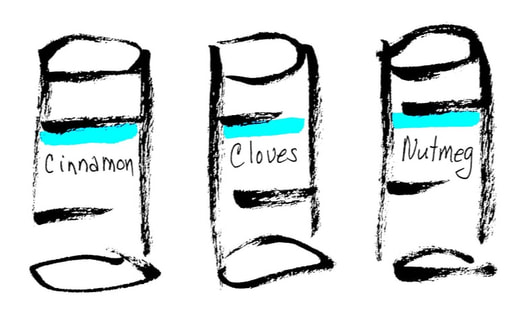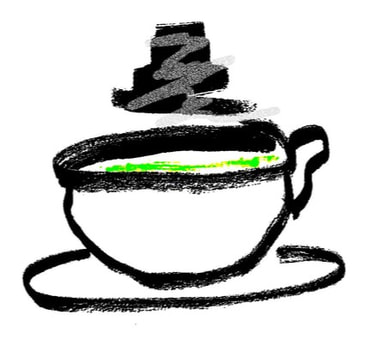 What do we mean by "spicy"? Think about the cache of spices in your kitchen. What do we mean by "spicy"? Think about the cache of spices in your kitchen. For the 2020 harvest, I purchased Syrah grapes from Lucas & Lewellen’s Valley View Vineyard in the Santa Ynez Valley. Today’s tasting of this spicy, savory wine reveals violets, lavender, cured meat, pink and black peppercorns, cranberries, blueberries, fresh bay leaf, petrichor/wet earth, cloves, bramble, cheddar cheese, shiitake mushroom and young tobacco. Opaque and purple in color, the wine is dry with high acidity, velvety tannins, high alcohol, and a medium body. What pleases me the most about this wine is the intensity of the perfume and flavor. The fruit concentration and tannins, along with high acidity and alcohol, bode well for aging the wine. The alcohol in this youthful and developing wine is a touch more pronounced than I would like, but this is common for a wine hailing from a warm region and from this variety. Though the alcohol level of a bottled wine does not change, I am hoping that time will mellow out the Syrah's overall balance. It is a vibrant wine that can use some taming. Syrah is one of several grapes that fall under the spicy category. Before we get too far ahead of ourselves, let’s examine what is meant when someone says a wine is “spicy.” Think about the cache of spices in your kitchen: cinnamon, cloves, pepper, nutmeg, anise, ginger, and cardamom being examples. You can actually smell and taste the natural chemical compounds of these spices not only when you reach into your spice cabinet but also when you drink a glass of wine. All fruits and plants, including grapes, draw from a common set of possible earthly elements, so it is no surprise that they share some chemical compounds. You don’t have to be an organic chemist to appreciate the excitement of detecting white pepper in your clam chowder as well as in your Grüner Veltliner. There are a great number of wines that bring spicy elements to the wine tasting experience. The next time you enjoy a Mourvèdre or Syrah from the Southern Rhone, consider “cola” as a possible spicy descriptor. Just knowing that such a flavor could occur opens our mind to the possibility of finding it in our wine. If you happen to smell cola’s bittersweet, sour, and spicy elements in your wine, give cola a shoutout. Do you smell cumin in your glass of wine? If so, this spice is sometimes found in cool-climate Pinot Noirs and in orange wines. Orange wines are white wines that are vinified in the same manner as red wines and are also described as skin-contact wines. “Baking spices” is a catchall term used for wines that exhibit a combination of spices common in pies and coffee cakes: ginger, cardamom, clove, nutmeg and coriander, to name a few. Stay open to the prospect of cinnamon aromas when you drink your next oaky Chardonnay or a Gewürztraminer or red wines made with Nebbiolo or Barbara grapes. Oak aging may contribute the aromas of cedar, cloves, sandalwood or vanilla. Viognier and Assyrtiko often carry the scent of ginger. Speaking of ginger and any flower, spice or fruit you detect in a wine, think about the evolution of the scent and its condition. Is the ginger fresh or stale? Candied? Dried? Is the pepper white, pink or black? Is the vanilla powerful as from a fresh pod or more like a diluted, low-cost extract? Is the star anise that you find in your California Zinfandel fresh and vibrant or aged and desiccated?  Every wine taster, from beginner to professional, is confused and intimidated at times when trying to sniff out specific spices and other flavors. Every wine taster, from beginner to professional, is confused and intimidated at times when trying to sniff out specific spices and other flavors. When professionals get together for a blind tasting, one goal is to identify the chemical compounds of specific fruits, flowers, spices, herbs, nuts and so on in the wine and to do so in vivid detail. It helps to visualize the spice you are naming but practical experience in the field is your best friend when it comes to identifying the universe of aromas found in wine. Many professionals hone this skill by smelling herbs and fruits from the farmers market. Follow their lead by memorizing the taste and smell of marmalade and marzipan over breakfast or dessert. Pay attention to the aromas of everything from leather to tobacco to smoke and wet soil. When it is time to bake, breathe in and taste the spices called for in the recipe. Ambitious wine tasters become cheese aficionados as well so they can identify specific cheese aromas in a blind wine tasting situation. Instead of identifying “cheese” in a wine, the knowledgeable taster may say “smoked Pecorino cheese” as one of several flavors identified. A study of the different types of mushrooms helps identify not only “mushroom” as an aroma but, more specifically, the type of mushroom, such as Cremini or Trumpet Royale. Tasters may invest time in understanding the different types of tea so they are able to distinguish white tea from black or green tea aromas in wine. They strive to understand the nuances of coffee and the different types and quality of chocolate. Nuts can also be a flavor, especially in deliberately oxidized wines such as Oloroso Sherry. Get to know the difference between walnuts, almonds, pecans, cashews, pistachios, hazelnuts and other types. Clearly, cooks and bakers have an edge when it comes to identifying spices and other aromas. While wine tasting may appear to be a niche interest, it actually encourages us to be rather curious about a range of gourmet topics, don’t you think? Essential oil kits with scents of truffle, pepper, chocolate, saffron, raspberry, green pepper and many other aromas are available to students of wine to help them with their identification skills. If you purchase such a kit, you will likely be offered an add-on wine faults kit to assist you in knowing exactly what is wrong like cork taint, reduction, volatile acidity and Brettanomyces. Such kits are not inexpensive but are an option for sharpening your blind tasting skills. Many professionals do not feel these kits are necessary; moreover, it is fun and easy to create your own aroma kit. Just fill a number of small bottles or vials with substances like pepper, star anise and other spices. Use stickers to hide the contents and assign a random three-digit number to each bottle. Note the numbers and their contents on a separate answer key. If you run with a group that is into novel experiences, bring your kit and ask each person to identify the aroma in each vial. Give the winner a bottle of wine. Now that’s a party game. You don’t have to be an organic chemist to appreciate the excitement of detecting white pepper in your clam chowder as well as in your Grüner Veltliner. When a client tells me she likes spicy wines, I have many choices at my disposal. The majority of fine red wines spend time in oak prior to bottling and that in itself is a common reason for finding spice in your wine. Some white wines also see time in oak. Or, spice can originate from the grape itself. When grapes are raw, most of their aroma molecules are bound up with sugar so you cannot detect spice. Place those grapes into alcoholic fermentation and the wine’s volatile flavor compounds are released, lifting the scent of spices to our nose. Fermentation in itself causes interactions between compounds that are highly complex and still being understood. In the case of my 2020 Syrah, I attribute the spiciness to the grapes because I did not use oak at any time in the production of the wine. One spice aroma in the Syrah, pepper, originates from a compound in the grape’s skin known as rotundone. This is the same compound found in black peppercorns. Grüner Veltliner, the most important indigenous grape of Austria, also has rotundone as part of its makeup and exudes pepper qualities. Some grapes are naturally prone to evolve into a spicy wine, like my Syrah. Other spicy flavors, such as the vanilla, butterscotch and coconut you might perceive, make their way into wine due to time spent in a cask. French oak is a popular choice for winemakers, offering subtle spiciness along with notes of cedar, hazelnut and smoke. American oak has a bolder presence, with a focus on coconut, vanilla and cinnamon. French oak is understood to impart a more silky texture to wine while American oak offers creaminess. The interplay of oxygen that occurs in both French and American oak gives the wine a rounder, more full-bodied texture than wines that do not see oak. So oak affects not only the flavor but also the texture of wine. New barrels exert a stronger flavor influence on wine than barrels that have been used more than once. When it is time for blending, a vintner may combine wine that spent time in new oak with wine that has slept in older casks, resulting in a wine that has partial new oak influence. New oak is expensive and expressive, so it is common for winemakers to use a combination of new and old oak in the development of a particular wine for both practical and aesthetic reasons. The smaller the cask, the more influence it will have on the wine because it has more physical contact with the wine than a larger cask. Barrels are toasted to various degrees with fire. A lighter toasting will have a more subtle effect on the wine as opposed to a barrel that has been toasted for a longer period of time. The longer the wine sits in a barrel, the more the barrel will impose its signature on the wine, affecting both the flavors and the texture of the wine.  Tasters may invest time in understanding the different types of tea so they are able to distinguish white tea from black or green tea aromas in wine. Tasters may invest time in understanding the different types of tea so they are able to distinguish white tea from black or green tea aromas in wine. From my own experience in winemaking with both commercial and wild yeasts, I can tell you that yeast selection has an influence on spiciness. Winemakers shop for commercial yeasts to be used during fermentation based on the characteristics they hope to achieve with their wine. Or, they can rely on the ambient yeast population in the vineyard, atmosphere and cellar to shape the development of the wine. Climate has a hand in spice development, along with vineyard selection, and when the grapes are picked in the vineyard. When spiciness is quite noticeable in a wine, a drinker will sometimes ask me whether the winemaker added spices while working with the wine in the cellar. In traditional winemaking, the answer is no. Wine science is always evolving, but it is thought that there are over one-thousand possible aroma compounds in wine. Every wine taster, from beginner to professional, is confused and intimidated at times when trying to sniff out specific spices and other flavors. There is so much going on in the glass. I personally find it easier to identify the characteristics that stand out the most in a wine, then put down the glass. I then go back to pick up additional aromas that I may have missed the first time. So basically, I go from the “loudest” scents to the “softest.” Typically, I run through the traditional wine tasting grid so I do not leave out an important observation such as the alcohol level or the length of the finish. In some cases, spice aromas jump out immediately. Take a few sniffs and allow yourself to visualize what you are smelling, then write down your impressions. While we all have lists of spices, fruits, herbs and other possible aromas to refer to, I find it more satisfying to treat each wine as an individual. I sniff the wine and ask myself, “What is this wine telling me?” Sometimes the answer has nothing to do with food, and it can be confusing or even shocking. What if you smell blood or copper or pee? Say what you smell aloud or write it down, even if you cannot believe your nose. I smelled pepper in a Pinot Noir this week even though it is a scent usually associated with the Syrah. If you are like me, you will be thrilled to find that other tasters have similar notes when you look up the wine later on the internet. Comparing your notes afterward with those of savvy tasters can help you, at the very least, gauge whether your observations are on track or, at best, confirm your prowess, leading to increased confidence. One note on housekeeping: temperature has a great impact on your wine’s expressiveness. If your wine is too cold, the spice and other aromas may be locked up until the wine warms to room temperature. When a wine is cold, I notice the structure of the wine, such as the tannins, alcohol, or acidity, more than the fruit. Once the wine warms, the fruit bursts forward and can change the overall perception of the wine. In general, I pull my reds from the fridge one hour prior to tasting and the whites half an hour prior. For fun, try tasting a wine cold from the fridge, then go back thirty to sixty minutes later to identify the spices and other flavors. The difference will astound you. In some cases, you will not believe you are drinking from the same bottle. This happened with my 2020 Syrah; the difference was startling. Whites: Assyrtiko Bourboulenc Chenin Blanc (South Africa) Coda di Volpe Cserszegi Füszeres Gewürztraminer Grüner Veltliner Muscat Blanc/Moscato Traminette Viognier Reds: Aglianico Barbera Blaufränkisch/Lemberger Bobal/Bovale Carménère Carignan/Cariñena/Mazuelo Chambourcin Cinsaut/Cinsault Dornfelder Frappato Fumin Gamaret Graciano Grenache/Garnacha Malbec Merlot Mondeuse Noire Montepulciano Mourvèdre/Mataro/Monastrell Nebbiolo Nerello Mascalese Nero d’Avola Petite Sirah Petit Verdot Pinot Noir Primitivo/Zinfandel Refosco (Colli Orientali) Ruchè Sangiovese Syrah/Shiraz Tannat Tempranillo Teroldego Trousseau/Bastardo Primitivo/Zinfandel This is one in a series of Grape Detective blogs featuring the attributes of wine and how your love for a specific wine grape may lead you to discover new grapes with similar characteristics. The focus of the list is grape variety and does not include blends, wine regions, or styles.
0 Comments
|
AuthorLyne Noella Archives
October 2022
Categories
All
|


 RSS Feed
RSS Feed
